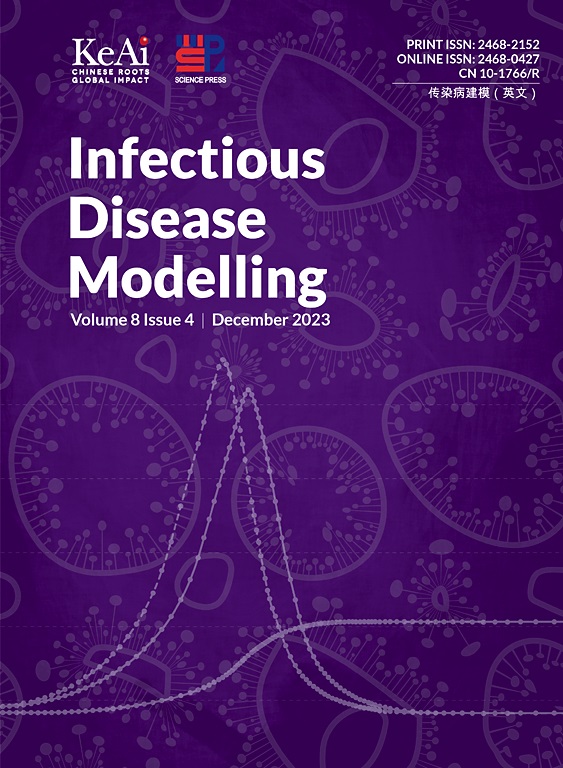A statistical model for forecasting probabilistic epidemic bands for dengue cases in Brazil
IF 2.5
3区 医学
Q1 Medicine
引用次数: 0
Abstract
Dengue is a vector-borne disease and a major public health concern in Brazil. Its continuing and rising burden has led the Brazilian Ministry of Health to request for modelling efforts to aid in the preparedness and response to the disease. In this context, we propose a Bayesian forecasting model based on historical data to predict the number of cases 52 weeks ahead for the 118 health districts of Brazil. We leverage the predictions to build probabilistic epidemics bands to be used for dengue monitoring. We define four disjoint probabilistic bands (≤50% (50%, 75%] (75%, 90%], and 90%), based on the percentiles of the predicted cases distribution and interpreted according to the historical number of cases and past occurrence probability (below the median, typical; moderately high, fairly typical; fairly high, atypical; exceptionally high, very atypical). We performed out-of-sample validation for 2022–2023 and 2023–2024 and forecasted 2024–2025. In the 2022–2023 and 2023–2024 seasons, the epidemic bands followed the observed cases’ curve shape, with a sharp increase after January and a decline after the peak around April. In 2022–2023, the observed number of cases (1,436,034) was slightly above the estimated 75% percentile (1,405,191), being classified as “fairly high, atypical”. Most health districts in South Brazil showed exceptionally high numbers of cases during this season. The situation worsened in 2023–2024 and the observed number of cases (6,454,020) was way above the 90% percentile (2,221,557), characterising an “exceptionally high, very atypical” season. For the 2024–2025 season, we estimated a median number of cases of 1,526,523 (maximum value for the “below the median, typical” probabilistic epidemic band. The maximum estimated values for the upper bands were 2,213,282 (moderately high, fairly typical) and 3,803,898 (fairly high, atypical) with the upper limits of the probabilistic epidemic bands of 1,452,359. Probabilistic epidemic bands serve as a valuable monitoring tool by enabling prospective comparisons between observed case curves and historical epidemic patterns, facilitating the assessment of ongoing outbreaks about past occurrences.
预测巴西登革热病例概率流行带的统计模型
登革热是一种病媒传播疾病,是巴西的一个主要公共卫生问题。它的持续和不断增加的负担导致巴西卫生部要求对努力进行建模,以帮助防范和应对该疾病。在这种情况下,我们提出了一个基于历史数据的贝叶斯预测模型,用于预测巴西118个卫生区未来52周的病例数。我们利用这些预测来建立用于登革热监测的概率流行频带。我们根据预测病例分布的百分位数定义了四个不相交的概率带(≤50%(50%,75%)(75%,90%)和>;90%),并根据历史病例数和过去发生概率(低于中位数,典型;中等高,相当典型;相当高,非典型;异常高,非常不典型)。我们对2022-2023年和2023-2024年进行了样本外验证,并预测了2024-2025年。在2022-2023年和2023-2024年季节,流行带呈观察病例曲线状,1月后急剧上升,4月左右达到峰值后下降。2022-2023年,观察到的病例数(1,436,034)略高于估计的75%百分位数(1,405,191),被归类为“相当高,非典型”。巴西南部大多数卫生区在本季节出现了异常高的病例数。2023-2024年,情况进一步恶化,观察到的病例数(6454020例)远高于90%的百分位数(22221557例),这是一个“异常高、非常不典型”的季节。对于2024-2025年季节,我们估计中位数病例数为1,526,523例(“低于中位数,典型”概率流行频带的最大值)。上波段的最大估计值为2,213,282(中等高,相当典型)和3,803,898(相当高,非典型),概率流行病波段的上限为1,452,359。概率流行带是一种有价值的监测工具,可以对观察到的病例曲线和历史流行模式进行前瞻性比较,促进对过去发生的正在发生的疫情进行评估。
本文章由计算机程序翻译,如有差异,请以英文原文为准。
求助全文
约1分钟内获得全文
求助全文
来源期刊

Infectious Disease Modelling
Mathematics-Applied Mathematics
CiteScore
17.00
自引率
3.40%
发文量
73
审稿时长
17 weeks
期刊介绍:
Infectious Disease Modelling is an open access journal that undergoes peer-review. Its main objective is to facilitate research that combines mathematical modelling, retrieval and analysis of infection disease data, and public health decision support. The journal actively encourages original research that improves this interface, as well as review articles that highlight innovative methodologies relevant to data collection, informatics, and policy making in the field of public health.
 求助内容:
求助内容: 应助结果提醒方式:
应助结果提醒方式:


